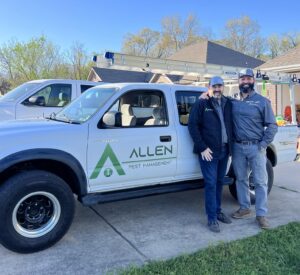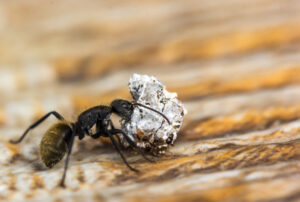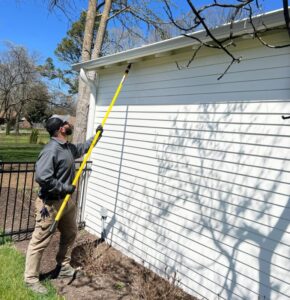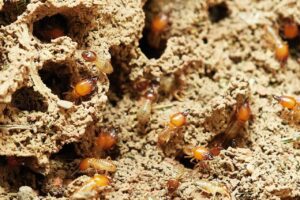Unlike other common household ants that simply forage for food, carpenter ants actually modify your property’s wooden elements to create their living spaces.
Many homeowners don’t realize they have a problem until significant damage has occurred. By understanding what makes carpenter ants different, you can spot early warning signs and protect your property.
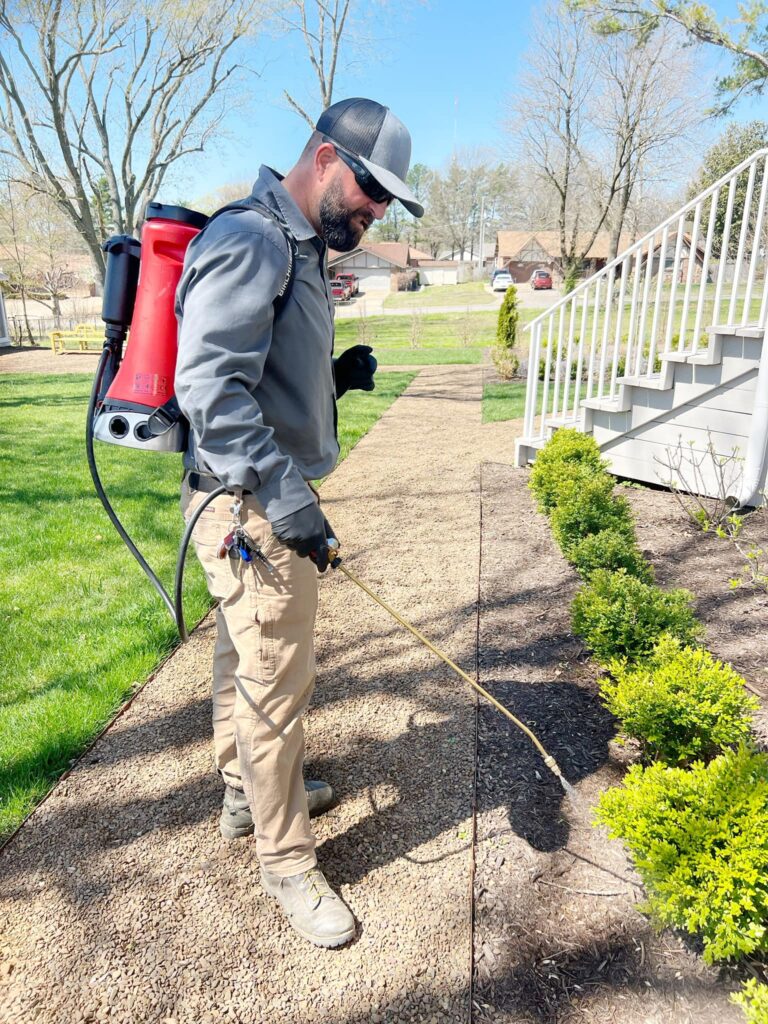
How Carpenter Ants Differ From Other Ants
Carpenter ants stand out from other ant species in several key ways. First, they’re larger than most other household ants, typically measuring between 6 to 12 mm in length. They’re usually black, though some species have reddish or yellowish coloring. Their thorax is smooth and rounded, giving them a distinctive profile.
But the main difference lies in their nesting behavior. While many ants build their nests in soil, carpenter ants create elaborate tunnel systems inside wood. They don’t eat wood. Instead, they remove wood, and when they do, they leave sawdust-like debris, called crass. They’re also attracted to sweets, meats, and other insects. This varied diet helps them thrive in many environments, including your home.
The Damage Carpenter Ants Can Cause
Carpenter ants target wood that’s already been softened by moisture or decay. Over time, they hollow out wooden beams, supports, trim, and furniture to create their nests. This excavation weakens the structural integrity of the wood.
In homes, carpenter ants often establish their colonies in:
- Wooden beams and support structures
- Wall voids, especially near kitchens and bathrooms
- Window and door frames
- Decks and porches
- Trees and stumps near the house
Left unchecked, a sizable carpenter ant colony can cause extensive damage that becomes expensive to repair. Unlike termites that might cause damage evenly throughout a wooden structure, carpenter ant damage often appears more concentrated and severe in specific areas.
Recognizing a Carpenter Ant Problem
The sooner you spot carpenter ants in your home, the less damage they’ll do to your wallet. Pay attention to these warning signals:
When wood gets hollowed out, it creates sawdust-like material called frass. Finding these tiny wood particles near baseboards or windowsills usually means ants are working nearby.
Ever pressed your ear to a wall and heard something moving? Carpenter ant colonies make subtle noises as they expand their tunnels. This sound often becomes noticeable at night when they’re most active.
The physical presence of large black or reddish ants in wet areas like bathrooms or under sinks often points to a nest. Unlike smaller ants that just search for crumbs, these larger ones suggest structural problems.
Test suspicious wooden elements by knocking gently on them. A dull, empty sound instead of a solid thud suggests the wood has been excavated from within.
During spring, carpenter ant colonies often produce winged reproductive ants. Finding these flying ants indoors typically signals a mature, established colony that’s been growing for some time.
Acting quickly when you notice these signs prevents minor issues from becoming major structural headaches.
Health and Property Risks
Beyond structural damage, carpenter ants pose other concerns for homeowners. While they don’t typically spread disease like some insects, certain species can bite when threatened. These bites can cause discomfort and potential allergic reactions in sensitive individuals.
Looking at your property’s health, the threats are substantial. The tunneling behavior of these insects weakens load-bearing wooden elements over time. Your furniture pieces and decorative wood items aren’t safe either. Their excavation work often creates openings where water seeps in, accelerating rot and decay. Left unchecked, the resulting structural issues can significantly decrease your home’s market value.
In commercial settings, especially food businesses, a carpenter ant issue can lead to customer concerns, reputation damage, and potential health code violations.
Stopping Carpenter Ants Before They Start
It costs much less to keep carpenter ants out than to remove them once they’ve settled in.
Try these defense strategies against carpenter ants and ant infestations:
Block All Access Routes
These insects slip through tiny openings to enter your home. Walk your property’s perimeter looking for entry possibilities – hairline foundation cracks, spaces around utility lines, or gaps in your siding. Caulk smaller openings and install door sweeps to eliminate access points.
Eliminate Dampness
Carpenter ants won’t build nests in dry wood. Track down and fix water leaks right away. Install exhaust fans in steamy areas like laundry rooms and showers. Consider running a dehumidifier in your basement or crawlspace to reduce overall moisture levels throughout your home.
Create a Buffer Zone Around Your Home
Your yard might unintentionally harbor carpenter ant colonies that eventually move indoors. Cut back shrubs and tree limbs so they don’t touch your house. Remove fallen trees, old stumps, and woodpiles that sit directly on the ground near your foundation.
Minimize Food Attractions
Though they nest in wood, carpenter ants forage for food in your living spaces. Wipe counters after meal prep, sweep floors regularly, and don’t leave pet food out overnight. Make a habit of emptying garbage containers frequently, especially when they contain food waste.
Look for Early Problems
Set calendar reminders to examine your home’s wooden elements quarterly. Pay extra attention to areas that get wet frequently or have had previous moisture issues.
Taking Action: Next Steps for Homeowners
If you suspect carpenter ants have invaded your property, don’t wait to address the problem. The longer these insects remain, the more damage they can cause.
Start with a thorough inspection of your property, looking for the signs mentioned earlier. If you spot evidence of carpenter ants, consider these steps:
- Document the problem by taking photos of damage and ant activity
- Address any obvious moisture issues immediately
- Remove any clearly infested wood that isn’t structural
- Contact a professional pest management service for evaluation
Carpenter ants represent a significant threat to wooden structures. Unlike many household pests that are merely nuisances, these insects can cause structural damage that compromises your home’s integrity and value.By understanding how carpenter ants operate, recognizing the early signs of infestation, and taking prompt action by getting help from a professional ant exterminator, you can protect your property from these destructive pests.


